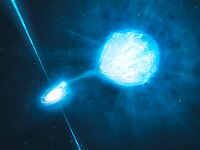
Photo from wikipedia
V2284 Cyg is a neglected W UMa-type binary star for photometric investigations. Monitored by the Kepler Space Telescope from 2009 to 2013, its light curves are continuously stable, suggesting that… Click to show full abstract
V2284 Cyg is a neglected W UMa-type binary star for photometric investigations. Monitored by the Kepler Space Telescope from 2009 to 2013, its light curves are continuously stable, suggesting that both components are inactive during this time interval. Based on the short-cadence observations, we determined the photometric solutions by using the 2013 version of the Wilson-Devinney code. These parameters reveal that V2284 Cyg is a W-type system with a degree of contact factor of f = 39.23% and a mass ratio of q = 2.90. Meanwhile, hundreds of times of minimum light were obtained and applied to analyze the orbital period changes. In the O-C diagram, a small-amplitude cyclic oscillation (A 3 = 0.00030 days and T 3 = 2.06 years) superimposed on a secular decreasing was found. The continuous decreasing may be a result from the mass transfer from the more massive component to the less massive one. With the long-term decreasing of the orbital period, this binary will evolve into a deeper contact system. Because the light curve is stable, the cyclic variation is plausibly explained as the light-travel time effect (LTTE) due to the presence of an additional body. The mass of the companion is . If the orbital plane inclination is a random distribution, it is a brown dwarf with 66.7% probability. Therefore, the companion of V2284 Cyg is possibly the first candidate of the brown dwarf orbiting around contact binary, where both component are sharing a common convective envelope.
Journal Title: Publications of the Astronomical Society of the Pacific
Year Published: 2017
Link to full text (if available)
Share on Social Media: Sign Up to like & get
recommendations!